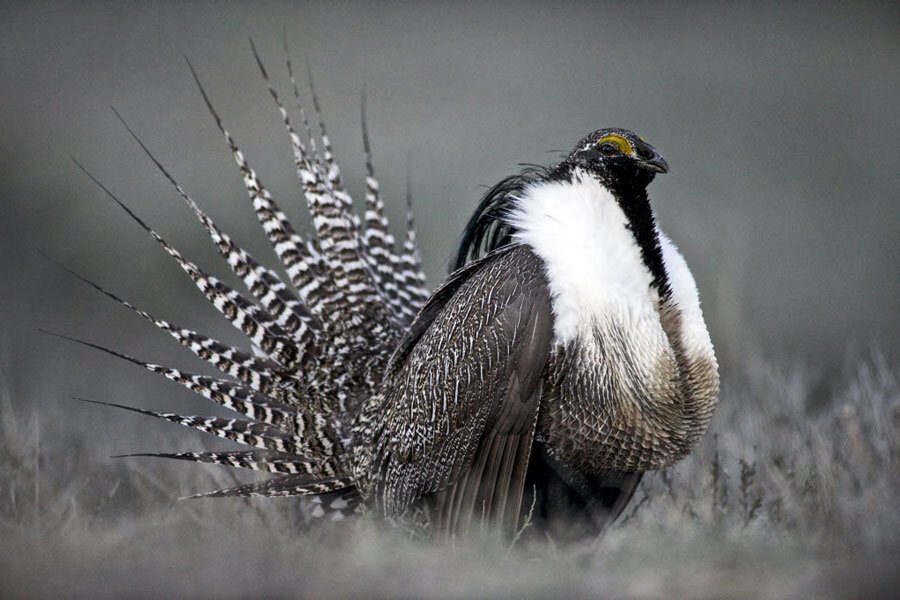Endangered species listing an issue in Western senate races
Loading...
An obscure, chicken-sized bird best known for its mating dance could help determine whether Democrats or Republicans control the U.S. Senate in November.
The federal government is considering listing the greater sage grouse as an endangered species next year. Doing so could limit development, energy exploration, hunting and ranching on the 165 million acres of the bird's habitat across 11 Western states.
Apart from the potential economic disruption, which some officials in Western states discuss in tones usually reserved for natural disasters, the specter of the bird's listing is reviving the centuries-old debates about local vs. federal control and whether to develop or conserve the region's vast expanses of land.
Two Republican congressmen running for the U.S. Senate in Montana and Colorado, Steve Daines and Cory Gardner, are co-sponsoring legislation that would prevent the federal government from listing the bird for a decade as long as states try to protect it.
"Montanans want locally driven solutions," Daines said in an interview. "They don't want bureaucrats thousands of miles away in Washington, D.C., dictating what should happen."
Environmentalists and the two Democratic senators being challenged, John Walsh in Montana and Mark Udall in Colorado, oppose the idea. They say they don't want a listing, either, but that the threat of one is needed to push states to protect the bird.
"A bill like what some in the House are proposing that would delay listing the bird would actually undermine locally driven efforts," said Udall spokesman Mike Saccone.
The greater sage grouse is described in the journals of explorers Meriwether Lewis and William Clark, and it once roamed widely across the massive sagebrush plateaus of the West's interior.
The bird is perhaps best known for its unusual springtime mating dance, during which it puffs its bulbous chest and emits odd warbles. But livestock grazing eroded the bristly plant that the bird depends upon, development chopped up its habitat and energy exploration erected towers that chased it away from its home range.
Rachel Carson warned in 1962 of the bird's possible demise in "Silent Spring," her classic environmental book.
Three environmental groups sued to force the federal government to protect the bird after the government declined to list it as endangered in 2005. In a 2010 settlement, the U.S. Fish and Wildlife Service agreed to decide on listing by September 2015.
A major factor will be whether the federal, state and local landowners whose land it inhabits protect the grouse. Many environmental groups say the bird is a stand-in for a vanishing Western ecosystem that needs preserving.
"This is the great landscape of America, when you travel west and see open spaces. This is all the stuff you grew up watching on television," said Randi Spivak of the Center for Biological Diversity in Tucson, Arizona, one of the groups that sued to force grouse protection. "And that land has been drilled, subdivided."
Industry groups and state governments worry about the cost.
A study by the Western Energy Alliance, a Denver-based trade organization of independent oil and gas producers, estimates that from 5,000 to 31,000 jobs could be lost should the federal government take steps to protect the grouse.
Kathleen Sgamma, the group's vice president of government and public affairs, said that as the federal government starts to draw up protections, energy leases are being deferred, drilling projects shut down and bureaucratic hurdles raised to any kind of development in the bird's range.
"It's another issue that's slowing economic growth and job development in the West," Sgamma said.
Local officials are alarmed, too.
Udall and other Colorado lawmakers pushed for the Obama administration to delay a decision on a far less prevalent species, the Gunnison sage grouse, until after the November elections. Federal land managers have already declared more than 400,000 acres off-limits to development to protect that bird. The Western Governors Association last month urged the federal government to defer to states on protecting the bird.
The administration announced last month that it would spend $32 million over 10 years helping ranchers in Nevada and California preserve the bird's habitat.
Industry leaders and environmental groups agree that the grouse can be protected without serious economic damage. Some point to Wyoming, the state with the greatest amount of both energy exploration and grouse, which has put in place a plan to conserve the bird's core habitat.
"It's based on sound science and helps us advance meaningful conservation of the species," said Jerimiah Rieman, energy and natural resources policy director for Gov. Matt Mead, R-Wyo.
Gardner, the Republican congressman from Colorado, and others opposed to a listing point to Wyoming as an example of why states should take the lead. "The states are working right now very diligently," Gardner said. "Once you list it, there's sort of a wall that comes down between people."
But environmentalists say the proposal amounts to a needless delay. Even Democrats who argue the federal government should defer to states don't support the Republican legislation.
Gov. John Hickenlooper, D-Colo., has warned against listing the bird and led a task force of Western governors who are trying to deal with the issue. A spokesman said Hickenlooper doesn't support the legislation because it lacks adequate bipartisan support.
Brian Rutledge, vice president of the Audubon Society's Rocky Mountain Region, said no one wants the bird to be listed but that the Endangered Species Act is working as intended in this case, to push local agencies to do conservation.
He was dismissive of the Republican proposal. "A lot of this," he said, "is just pandering."







